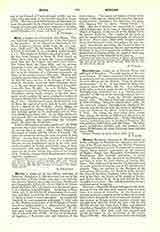

Myra, a titular see of Lycia in Asia Minor. The city was from time immemorial one of the chief places in the province. It was situated on the banks of the River Andriacos, twenty stadia from the sea (Appian, “Bell. civil.”, IV, 82; Strabo, XIV, iii, 7; Pliny, XXXII, 8; Ptolemy, V, vi, 3; Stephen of Byzantium, s.v.). The hamlet of Andriaca served as its port. On his way from Caesarea to Rome St. Paul stayed at Myra (Acts, xxvii, 5); at least the “textus receptus” reads thus, but the Vulgate has substituted Lystra. The Codex Bez, the Gigas Bible, and the ancient Egyptian version also mention Myra after Patara of Lycia (Acts, xxi, 1). The “Acta Pauli” probably testify as to the existence of a Christian community at Myra in the second century (Harnack, “Mission and Ausbreitung des Christentums”, 465, 487). Le Quien (I, 965-70) opens his list of the bishops of this city with St. Nicander, martyred under Domitian about A.D. 95, and whose feast is celebrated November 4 (Acta SS., November, II, 225). As to St. Nicholas Thaumaturgus, venerated on December 6, the “Index” of Theodorus Lector (sixth century) is the first document which inscribes his name among the fathers of Nicaea in 325 (Gelzer, “Patrum Nicmnorum nomina”, 67, n. 151). Theodosius II made the flourishing city of Myra the capital of Lycia and, it is said, erected there a church to St. Nicholas. Peter, Bishop of Myra composed in defense of the Council of Chalcedon writings quoted by St. Sophronius and by Photius (Bibliotheca, Codex 23). At the Sixth Ecumenical Council (787) two bishops of Myra, Theodore and Nicholas, assisted, one representing the orthodox party, the other the Iconoclasts.
Eubel (“Hierarchia catholica medii nevi”, II, 1370) mentions five Latin titulars of the fifteenth century. At present Myra is only a village called Dembre in the sanjak of Adalia and the vilayet of Koniah. Its ruins are numbered among the most beautiful of Asia Minor. Among them are the remains of a temple of Apollo, mentioned by Pliny, those of a magnificent theatre, several burial places hewn in the rock, with tombs inscribed in Lycian and Greek, some of them ornamented with bas-reliefs. Numerous Christian ruins are also found, among them those of the Church of St. Nicholas, around which Russians have recently erected a monastery.
S. SALAVILLE

